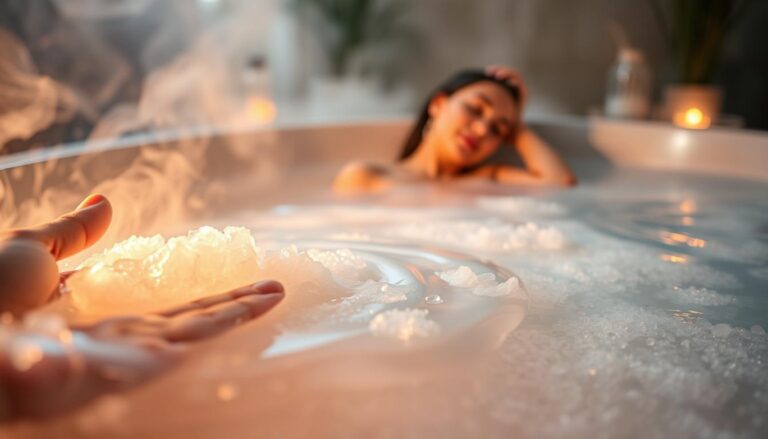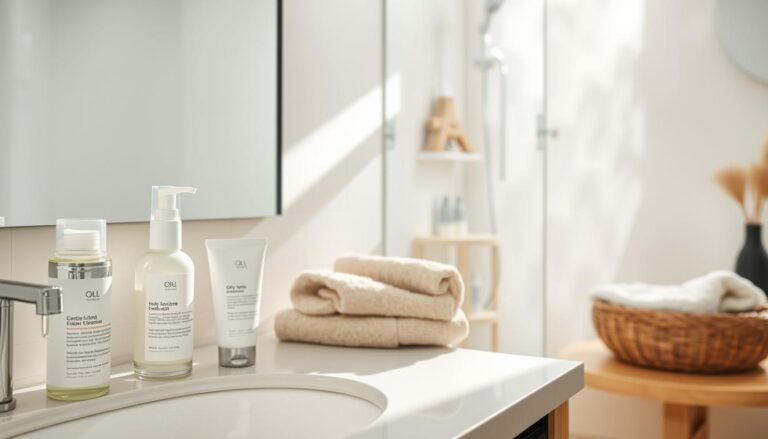At Glowskinhub.com, we believe beauty isn’t just a look—it’s a feeling
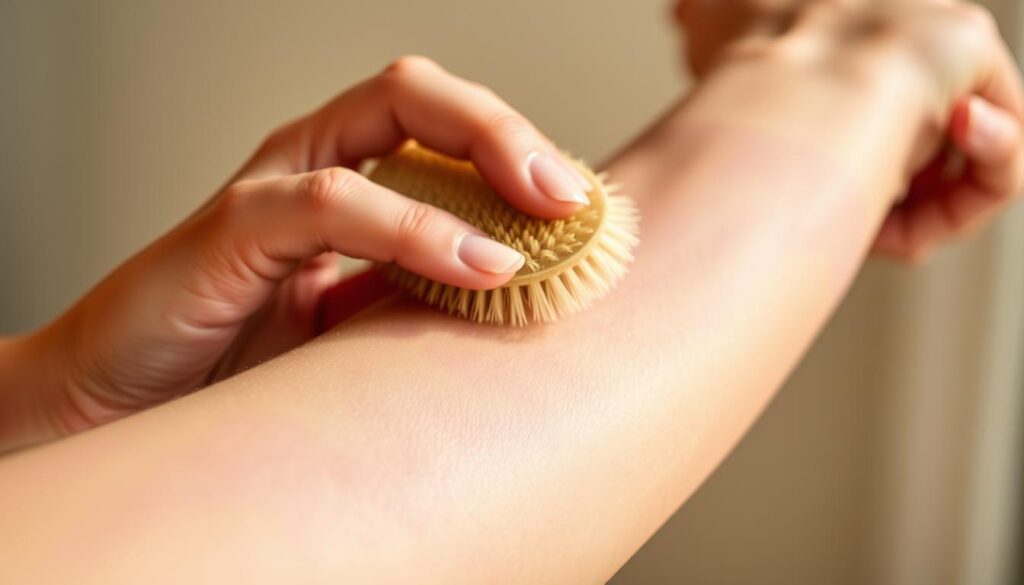
The benefits of dry brushing before shower
Incorporating dry brushing into your skincare routine can have a significant impact on your Skin’s health.
This technique involves gently brushing your Skin with a dry brush to remove dead Skin cells and improve circulation.
By doing so, you can achieve smoother Skin and potentially reduce the appearance of ingrown hairs and other Skin irritations.
As part of your pre-shower routine, dry brushing can be a refreshing and invigorating way to start your day.
Key Takeaways
- Improves Skin texture by removing dead Skin cells
- Enhances circulation, potentially aiding in overall Skin health
- Can help reduce ingrown hairs and Skin irritations
- A simple, low-cost addition to your skincare routine
- Invigorating and refreshing when done before a shower
What Is Dry Brushing?
Dry brushing is an ancient practice that has been revitalized in modern times for its numerous skincare benefits. This simple technique involves gently brushing the Skin with a soft-bristled brush without any lotion or water.
The Ancient Practice of Dry Brushing
The art of dry brushing has its roots in ancient cultures, where it was valued for its numerous health benefits. Civilizations such as the Egyptians and Greeks practiced various forms of dry brushing for both physical and spiritual well-being.
How Dry Brushing Works
Dry brushing works by removing dead Skin cells, improving circulation, and stimulating the lymphatic system. The gentle friction from the brush helps to exfoliate the Skin, leaving it smoother and more radiant.
| Benefits | Description |
|---|---|
| Exfoliation | Removes dead Skin cells, revealing smoother Skin. |
| Circulation Improvement | Enhances blood flow, potentially improving overall Skin health. |
| Lymphatic Stimulation | Aids in detoxification by stimulating the lymphatic system. |
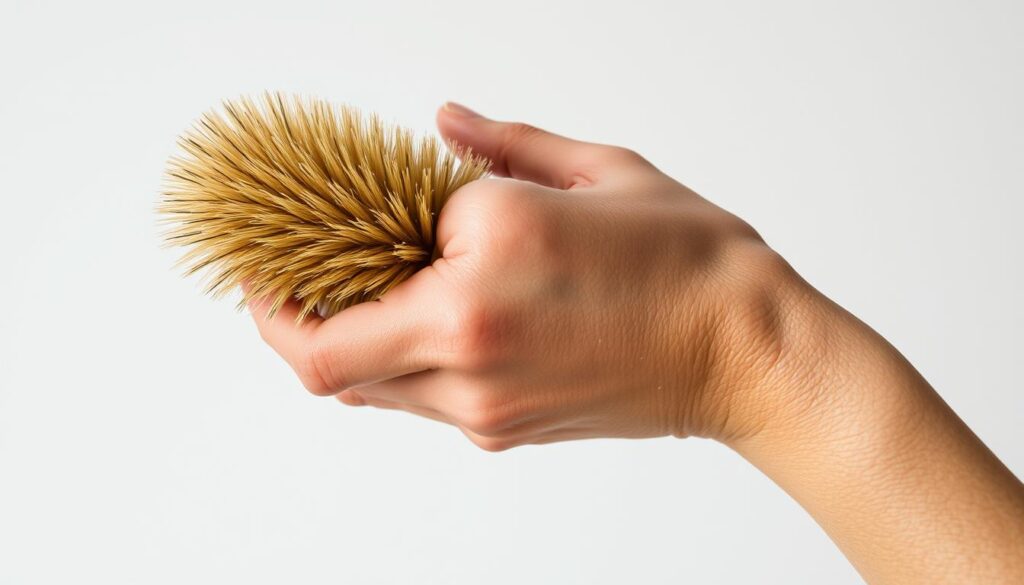
The Benefits of Dry Brushing Before Shower
Dry brushing before showering is a practice that has gained popularity due to its numerous benefits for the Skin and overall well-being. The act of dry brushing stimulates the Skin, potentially leading to a range of positive effects on both physical and mental health.
Physical Benefits
Dry brushing can have several physical benefits, particularly when done before showering. These benefits can be seen in both the immediate effects and the long-term improvements.
Immediate Effects
One of the immediate effects of dry brushing is the removal of dead Skin cells, which can leave the Skin feeling smoother and looking brighter. Additionally, dry brushing can help stimulate blood circulation, potentially leading to a healthier and more radiant complexion. Improved circulation can also aid in reducing the appearance of varicose veins and promoting overall cardiovascular health.
Long-term Improvements
Regular dry brushing can lead to long-term improvements in Skin health, including reduced appearance of cellulite and improved Skin tone. By consistently removing dead Skin cells and stimulating circulation, dry brushing can contribute to healthier, more youthful-looking Skin over time.
Mental and Emotional Benefits
Beyond the physical benefits, dry brushing can also have a positive impact on mental and emotional well-being. The gentle, repetitive motion of dry brushing can be meditative, helping to reduce stress and promote relaxation. Furthermore, the sense of accomplishment and self-care that comes from incorporating dry brushing into one’s routine can enhance overall mental health.
Exfoliation and Skin Cell Renewal
One of the primary benefits of dry brushing is its ability to exfoliate and renew Skin cells. By removing dead Skin cells, dry brushing helps to reveal smoother, healthier-looking Skin.
How Dry Brushing Removes Dead Skin Cells
Dry brushing works by gently removing the top layer of dead Skin cells through a gentle brushing action. This process not only improves Skin texture but also helps to unclog pores, making it particularly beneficial for individuals with oily Skin.
Promoting Healthier, Younger-Looking Skin
Regular dry brushing can lead to healthier, younger-looking Skin by promoting cell turnover. This process helps to keep the Skin looking vibrant and fresh.
Enhanced Product Absorption
After dry brushing, the Skin is more receptive to skincare products. By removing dead Skin cells, dry brushing allows oily Skin products and skincare for oily Skin to penetrate deeper into the Skin, enhancing their effectiveness.
Some key benefits of dry brushing for exfoliation include:
- Removal of dead Skin cells
- Improved Skin texture
- Enhanced absorption of skincare products
- Promoting healthier, younger-looking Skin
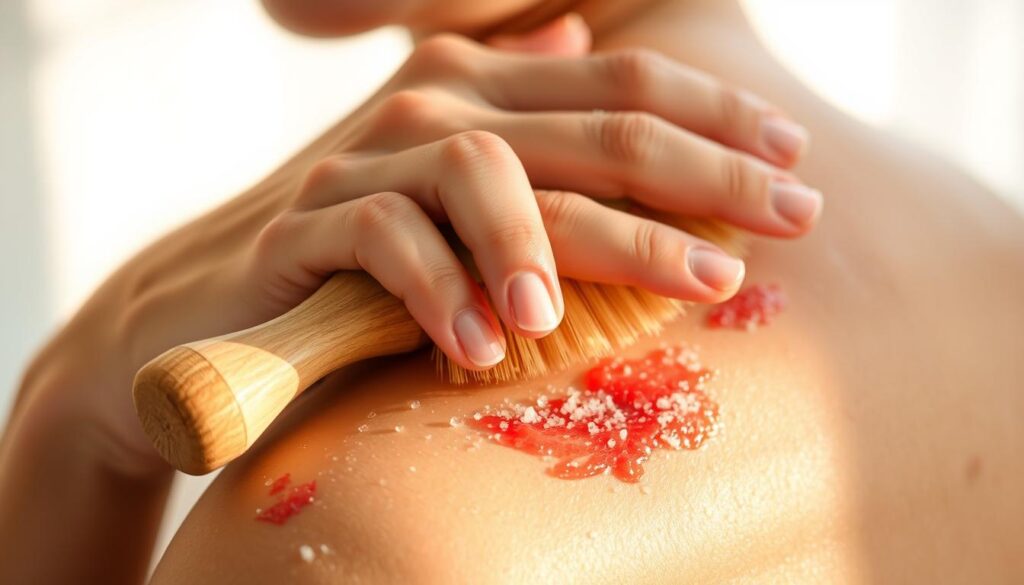
Improving Blood Circulation Through Dry Brushing
Dry brushing is a simple technique that can significantly enhance blood circulation. By stimulating the Skin, dry brushing helps to improve the flow of blood throughout the body, which can have numerous health benefits.
The Science Behind Enhanced Circulation
When you dry brush, you are stimulating the blood vessels near the surface of the Skin. This stimulation can help to dilate the blood vessels, allowing for increased blood flow. As a result, the Skin receives more oxygen and nutrients, which can lead to healthier, more radiant Skin.
According to a study published in the Journal of Cosmetic Dermatology, regular exfoliation through dry brushing can improve circulation and overall Skin health
“Exfoliation is an essential step in any skincare routine, and dry brushing is a simple and effective way to achieve this.”
Long-term Benefits for Cardiovascular Health
Regular dry brushing can have long-term benefits for cardiovascular health. Improved blood circulation can help to reduce the risk of cardiovascular disease by ensuring that the heart is not overworked. Additionally, dry brushing can help to lower blood pressure and improve overall vascular health.
Warming the Body Naturally
Dry brushing can also help to warm the body naturally by increasing blood flow to the Skin. This can be particularly beneficial during colder months or for individuals who tend to feel cold.
| Benefits of Dry Brushing | Description |
|---|---|
| Improved Blood Circulation | Increased blood flow throughout the body |
| Cardiovascular Health | Reduced risk of cardiovascular disease |
| Warmer Body | Naturally increased body temperature |
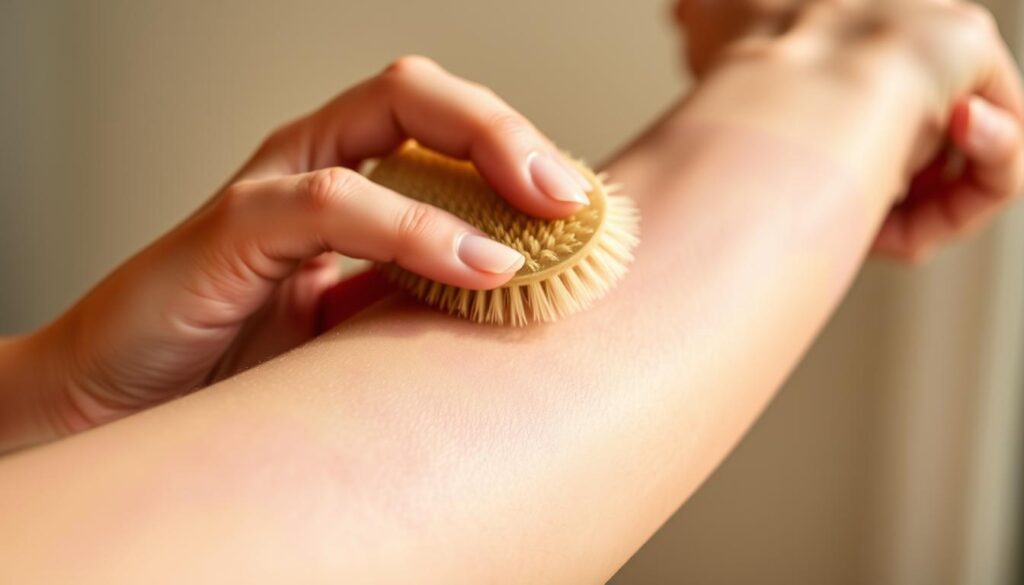
Lymphatic System Stimulation
The lymphatic system plays a crucial role in our body’s detoxification process, and dry brushing can significantly enhance its function. The lymphatic system is a network of vessels, organs, and tissues responsible for the transport of lymph fluid throughout the body. It plays a key role in immune function and overall health by filtering out harmful substances.
Understanding the Lymphatic System
The lymphatic system is often overlooked until it becomes compromised. It is essential for removing toxins and proteins from the body tissues, among other functions. Unlike the circulatory system, the lymphatic system does not have a pump (like the heart) and relies on movement and external stimulation to function properly.
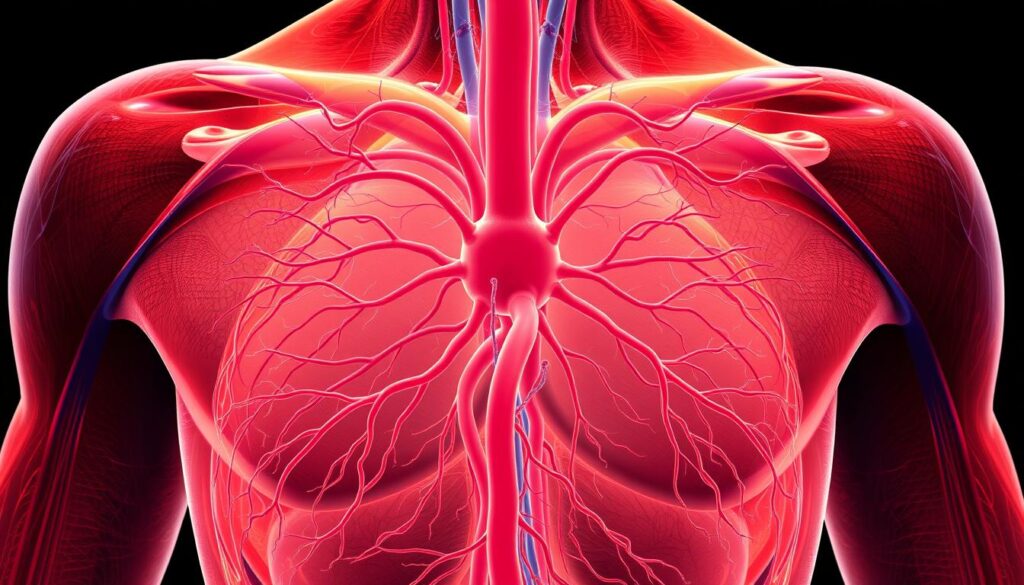
How Dry Brushing Supports Detoxification
Dry brushing is a simple method to stimulate the lymphatic system. By gently brushing the Skin, you can enhance lymphatic circulation, promoting the removal of toxins. This can lead to improved overall health and a reduction in certain health issues.
Reducing Fluid Retention
One of the benefits of enhanced lymphatic circulation through dry brushing is the reduction of fluid retention. When the lymphatic system is functioning optimally, it can more effectively remove excess fluids from the body, reducing swelling and discomfort.
| Benefits of Dry Brushing for the Lymphatic System | Description |
|---|---|
| Enhanced Detoxification | Improved removal of toxins from the body |
| Reduced Fluid Retention | Less swelling due to efficient lymphatic drainage |
| Boosted Immune Function | Better overall immune response |
Reducing the Appearance of Cellulite
Cellulite, a common concern for many, may be addressed through the simple practice of dry brushing. This technique, when incorporated into a regular skincare routine, can potentially improve the appearance of Skin affected by cellulite.
Can Dry Brushing Really Help with Cellulite?
Dry brushing is believed to help reduce the appearance of cellulite by improving circulation and promoting lymphatic drainage. Enhanced blood flow can aid in breaking down fat cells that contribute to the dimpled appearance of cellulite.
Complementary Practices for Cellulite Reduction
While dry brushing can be beneficial, combining it with other practices may enhance results. Consider incorporating:
- A healthy diet rich in fruits, vegetables, and whole grains
- Regular exercise, including strength training and cardio
- Adequate hydration to keep Skin supple and hydrated
Realistic Expectations and Results
It’s essential to have realistic expectations when using dry brushing to reduce cellulite. Results can vary, and consistency is key. Regular dry brushing, combined with a healthy lifestyle, may lead to noticeable improvements over time.

By understanding the potential benefits and limitations of dry brushing for cellulite, individuals can make informed decisions about incorporating this technique into their skincare routine.
Choosing the Right Dry Brush
Selecting the ideal dry brush is crucial for maximising the benefits of dry brushing. With so many options available, it can be challenging to determine which brush is best suited for your needs.
Types of Dry Brushes
Dry brushes come in various types, each designed for specific purposes. Some are designed for general use, while others are tailored for sensitive areas or for use on particular Skin types.
Materials and Bristle Firmness
The material and bristle firmness of a dry brush are critical factors. Brushes can be made from natural or synthetic materials, and the firmness can range from soft to very firm. Natural bristles are often preferred for their gentleness and effectiveness.
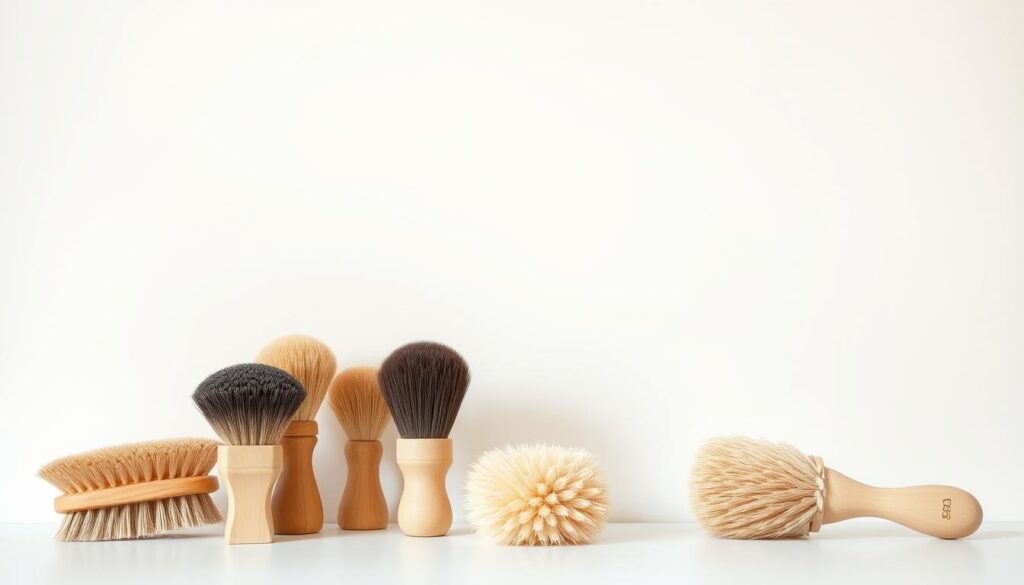
Handles vs. Hand-held Brushes
Dry brushes are available with or without handles. Hand-held brushes offer more control, while handled brushes can be more convenient for reaching certain areas. Consider your personal preference and needs when deciding.
Investment Considerations
When investing in a dry brush, consider the quality and durability. A good-quality brush may be more expensive but is likely to last longer and perform better. It’s worth investing in a brush that meets your needs and provides the desired results.
Step-by-Step Dry Brushing Technique
A well-executed dry brushing routine can significantly enhance your Skin’s health and appearance. To achieve this, it’s essential to follow a proper technique.
Preparing for Your Dry Brushing Session
Before you start, ensure you’re using the right brush. Choose a dry brush with natural bristles and a comfortable handle. It’s also advisable to dry brush in a well-lit area so you can see what you’re doing.
The Correct Brushing Direction
Always brush towards your heart. For your arms, brush from your hands towards your shoulders. For your legs, brush from your feet up towards your groin. On your torso, brush in circular motions, starting from the centre and moving outwards.
Areas to Focus On and Areas to Avoid
Pay particular attention to areas prone to cellulite or dry Skin, such as thighs and elbows. However, avoid brushing sensitive areas, broken Skin, or areas with active acne.
Adjusting Pressure for Different Body Parts
The pressure you apply should vary depending on the area. For thicker Skin areas like the soles of your feet and elbows, you can apply more pressure. For more delicate areas, reduce the pressure to avoid irritation.
| Body Area | Recommended Pressure |
|---|---|
| Thick Skin areas (e.g., feet, elbows) | High |
| Sensitive areas (e.g., abdomen, neck) | Low |
By following these steps and being mindful of your technique, you can maximize the benefits of dry brushing and enjoy healthier, more radiant Skin.
Incorporating Dry Brushing into Your Skincare Routine
Making dry brushing a part of your regular skincare routine can lead to noticeable improvements in Skin texture and tone. To achieve the best results, it’s crucial to understand how to integrate dry brushing effectively.
Ideal Frequency for Dry Brushing
For most Skin types, dry brushing 2-3 times a week is sufficient. However, if you have sensitive Skin, you may want to start with once a week and gradually increase the frequency as your Skin becomes more tolerant.
Best Time of Day for Dry Brushing
The best time to dry brush is before showering, ideally in the morning. This helps stimulate circulation and energize the Skin for the day ahead. Avoid dry brushing at night as it can interfere with your ability to wind down before bed.
Post-Brushing Skin Care
After dry brushing, showering with warm water helps to remove the dead Skin cells that have been loosened. Following your shower, apply a nourishing moisturizer to hydrate the Skin. For oily Skin, consider using products containing salicylic acid or tea tree oil to help control oil production without clogging pores.
Complementary Products for Oily Skin
When choosing products for oily Skin, look for lightweight, non-comedogenic formulas that won’t clog pores. Oil-free moisturisers and clay-based masks can be particularly beneficial in maintaining Skin health without exacerbating oiliness.
Dry Brushing for Different Skin Types
Whether you have sensitive, oily, or mature Skin, dry brushing can be a valuable addition to your skincare routine when done correctly.
Dry Brushing for Sensitive Skin
For those with sensitive Skin, it’s crucial to approach dry brushing with care. Use a soft-bristled brush and gentle strokes to avoid irritation. Begin with light pressure and gradually increase as your Skin becomes more tolerant.
Dry Brushing for Oily Skin
Dry brushing can be particularly beneficial for oily Skin, helping to remove excess oil and reduce the appearance of pores.
Balancing Oil Production
Regular dry brushing can help in balancing oil production by removing dead Skin cells and improving Skin circulation.
Preventing Breakouts
By keeping the Skin clean and exfoliated, dry brushing can also help prevent breakouts that occur when pores are clogged with oil and dead Skin cells.
Adjusting Technique for Mature Skin
For mature Skin, it’s essential to be gentle while still being effective. Use a softer brush and be mindful of Skin fragility. Dry brushing can help improve Skin tone and reduce the appearance of fine lines.
Here’s a summary of how to adjust dry brushing for different Skin types:
| Skin Type | Brush Type | Technique |
|---|---|---|
| Sensitive | Soft-bristled | Gentle strokes, light pressure |
| Oily | Medium-bristled | Firmer strokes to remove excess oil |
| Mature | Soft-bristled | Gentle, careful not to pull or tug |
Potential Side Effects and Contraindications
Understanding the potential contraindications of dry brushing is crucial for a safe and effective skincare routine. While it offers numerous benefits, there are certain conditions under which dry brushing should be avoided or approached with caution.
When to Avoid Dry Brushing
Dry brushing is not recommended for individuals with certain Skin conditions, such as eczema, psoriasis, or open wounds. It’s also advisable to avoid dry brushing areas with varicose veins or broken capillaries.
Signs You’re Brushing Too Hard
If you experience redness, irritation, or discomfort during or after dry brushing, it may be a sign that you’re brushing too hard. Adjusting the pressure or switching to a softer brush can help alleviate these issues.
Addressing Skin Reactions
If you notice any adverse reactions, such as itching or rashes, after dry brushing, discontinue the practice until your Skin returns to normal. For persistent issues, consulting a dermatologist is recommended.
| Condition | Precaution |
|---|---|
| Eczema/Psoriasis | Avoid dry brushing affected areas |
| Open Wounds | Avoid dry brushing until healed |
| Varicose Veins | Gentle brushing or avoidance |
Conclusion
Dry brushing is a straightforward and effective technique that can significantly enhance your skincare routine. By incorporating dry brushing into your daily regimen, you can enjoy numerous benefits, including exfoliation, improved blood circulation, and lymphatic system stimulation.
For individuals with oily Skin, dry brushing can be particularly beneficial as part of an oily Skin treatment. It helps remove dead Skin cells and promote healthier Skin. When combined with a best skincare routine for oily Skin, dry brushing can lead to a more balanced and radiant complexion.
By understanding the benefits of dry brushing and how to properly incorporate it into your skincare routine, you can take a proactive approach to achieving healthier, more youthful-looking Skin. As a simple addition to your daily routine, dry brushing can make a significant difference in your overall Skin health and appearance.


